Abstract
The release of catecholamines from adrenal chromaffin cells is known to be blocked by dihydropyridines, such as nitrendipine, and enhanced by others, such as BAY K8644. On the other hand, release from sympathetic neurons is predominantly insensitive to these agents. Release of [3H]norepinephrine from undifferentiated PC-12 pheochromocytoma cells resembles that from chromaffin cells in that it is extremely sensitive to dihydropyridines. Following differentiation, however, release of catecholamine becomes predominantly insensitive to both nitrendipine and BAY K8644. Under both growth conditions, release remains completely blocked by 3 mM Co2+ or by removal of Ca2+ from the release media. Dose-response curves to K+ show that following differentiation, cells become more sensitive, releasing transmitter at lower K+ concentrations. In contrast, depolarization-induced uptake of 45Ca2+ remains sensitive to dihydropyridines and shows similar sensitivity to K+ stimulation in both growth conditions. These results can be explained by invoking a model involving dihydropyridine-sensitive and -insensitive types of voltage-sensitive calcium channels.
Full text
PDF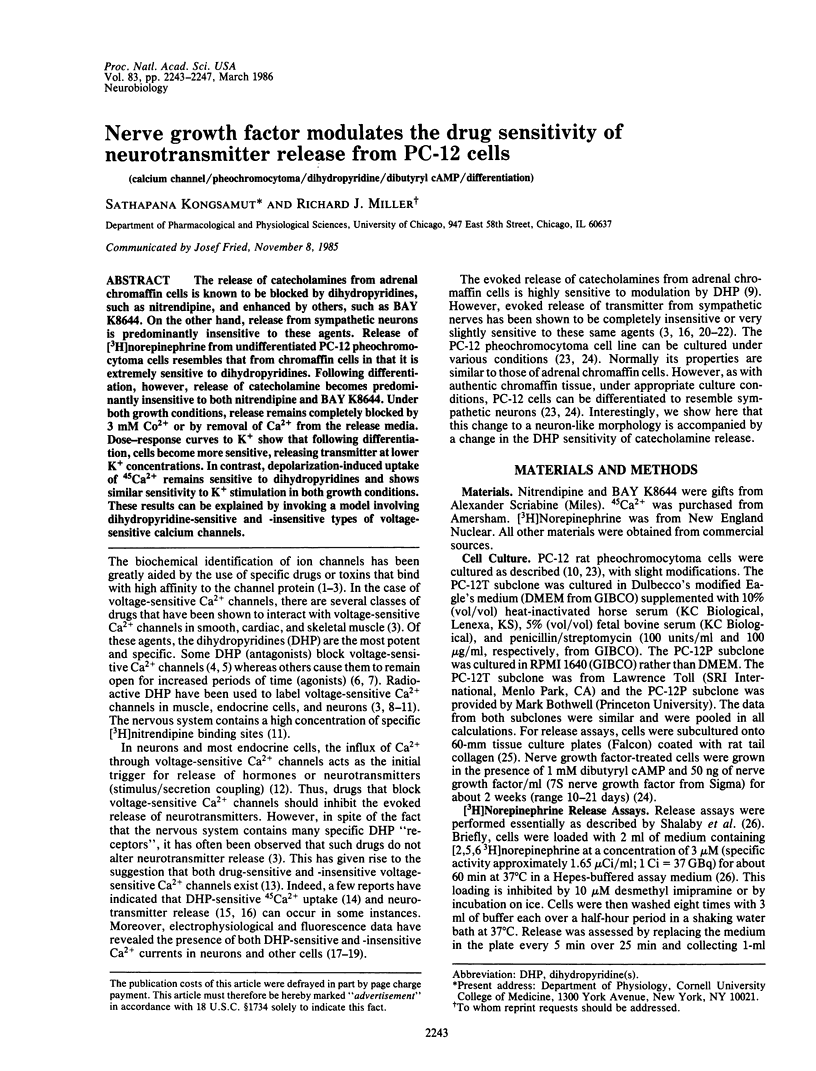
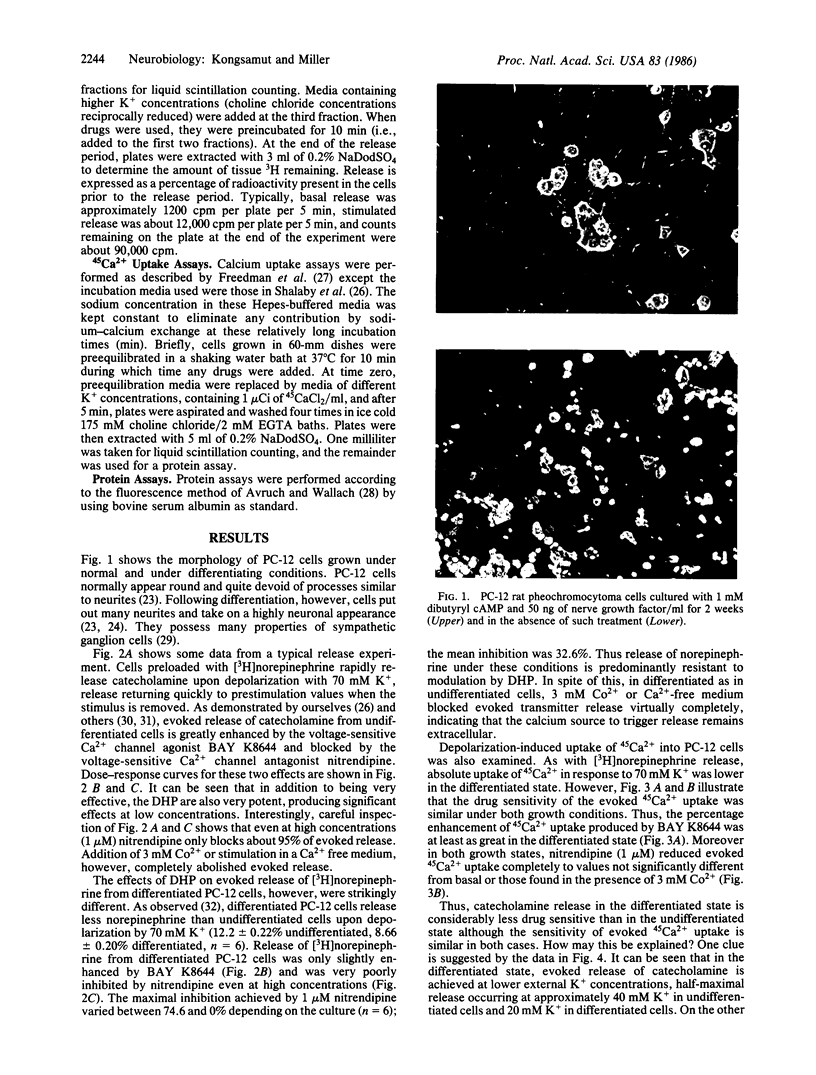
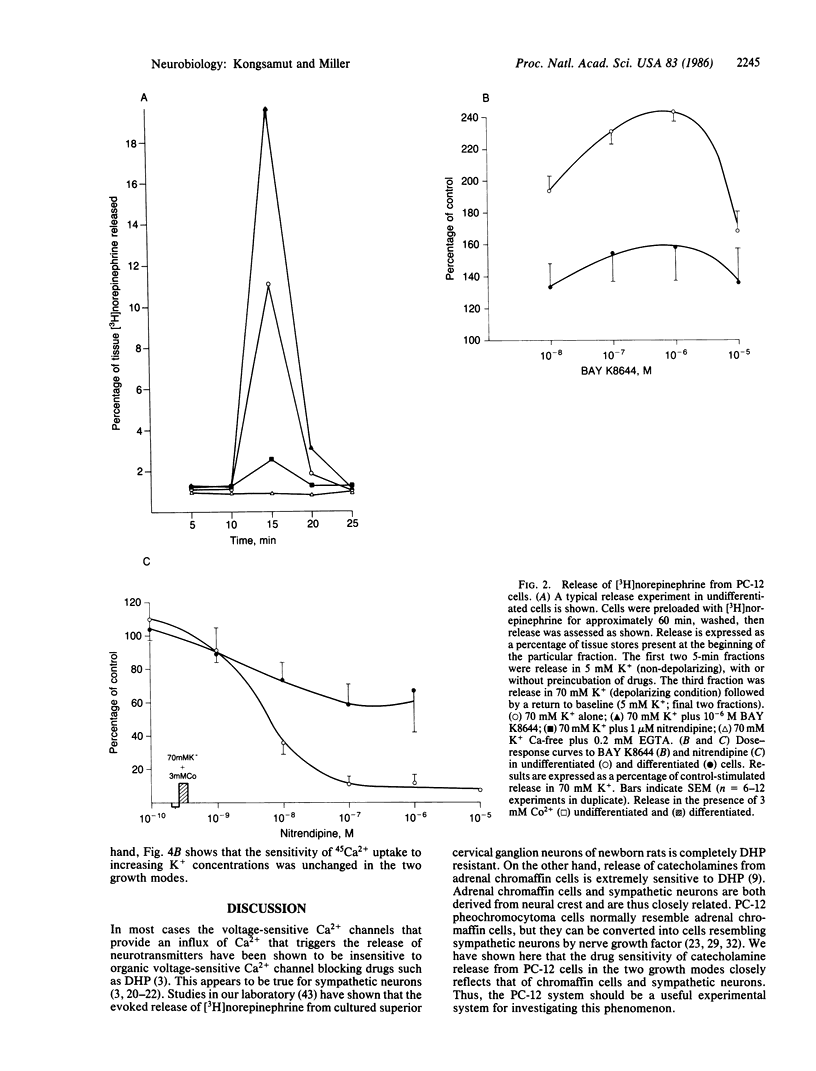
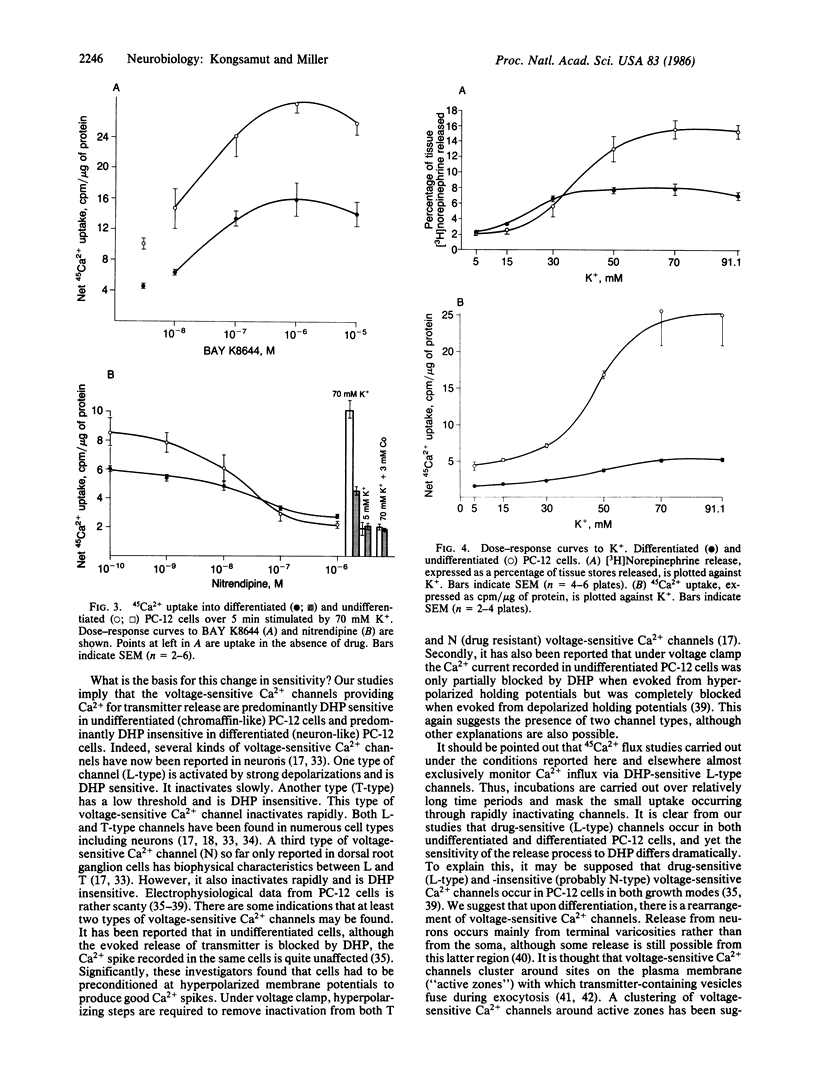
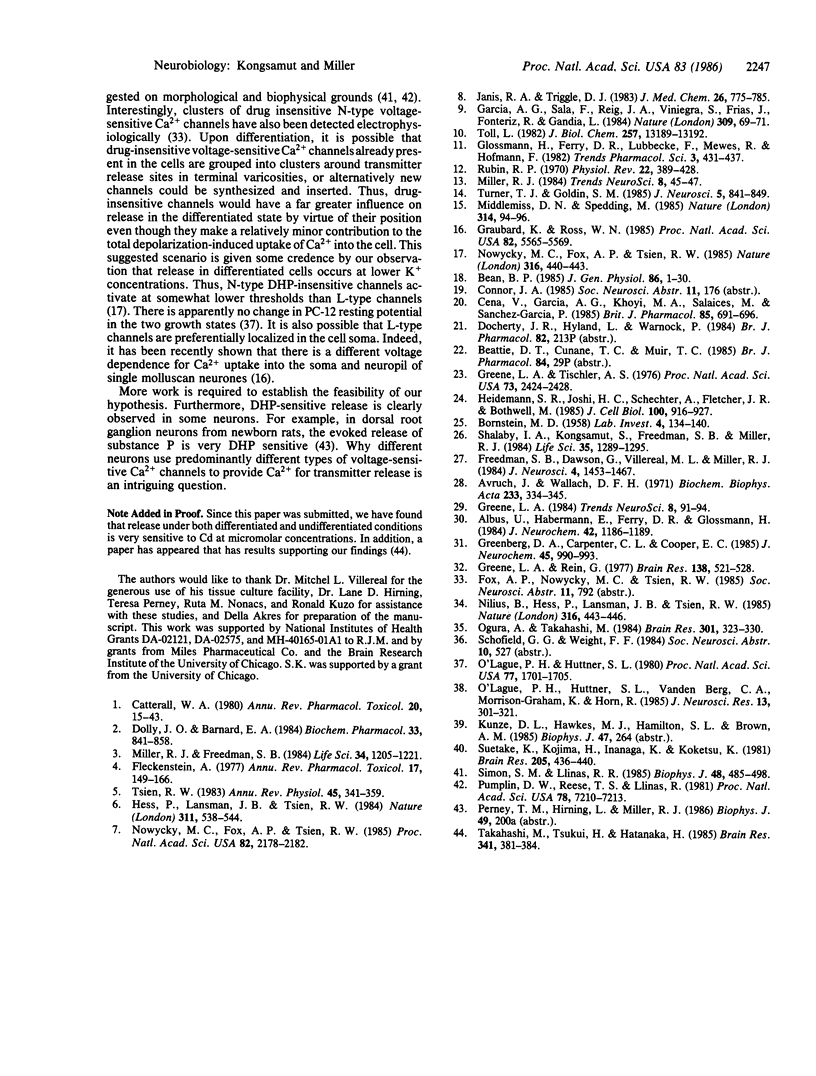
Images in this article
Selected References
These references are in PubMed. This may not be the complete list of references from this article.
- Albus U., Habermann E., Ferry D. R., Glossmann H. Novel 1,4-dihydropyridine (Bay K 8644) facilitates calcium-dependent [3H]noradrenaline release from PC 12 cells. J Neurochem. 1984 Apr;42(4):1186–1189. doi: 10.1111/j.1471-4159.1984.tb12729.x. [DOI] [PubMed] [Google Scholar]
- Avruch J., Wallach D. F. Preparation and properties of plasma membrane and endoplasmic reticulum fragments from isolated rat fat cells. Biochim Biophys Acta. 1971 Apr 13;233(2):334–347. doi: 10.1016/0005-2736(71)90331-2. [DOI] [PubMed] [Google Scholar]
- BORNSTEIN M. B. Reconstituted rattail collagen used as substrate for tissue cultures on coverslips in Maximow slides and roller tubes. Lab Invest. 1958 Mar-Apr;7(2):134–137. [PubMed] [Google Scholar]
- Bean B. P. Two kinds of calcium channels in canine atrial cells. Differences in kinetics, selectivity, and pharmacology. J Gen Physiol. 1985 Jul;86(1):1–30. doi: 10.1085/jgp.86.1.1. [DOI] [PMC free article] [PubMed] [Google Scholar]
- Catterall W. A. Neurotoxins that act on voltage-sensitive sodium channels in excitable membranes. Annu Rev Pharmacol Toxicol. 1980;20:15–43. doi: 10.1146/annurev.pa.20.040180.000311. [DOI] [PubMed] [Google Scholar]
- Ceña V., García A. G., Khoyi M. A., Salaices M., Sanchez-García P. Effect of the dihydropyridine Bay K 8644 on the release of [3H]-noradrenaline from the rat isolated vas deferens. Br J Pharmacol. 1985 Jul;85(3):691–696. doi: 10.1111/j.1476-5381.1985.tb10565.x. [DOI] [PMC free article] [PubMed] [Google Scholar]
- Dolly J. O., Barnard E. A. Nicotinic acetylcholine receptors: an overview. Biochem Pharmacol. 1984 Mar 15;33(6):841–858. doi: 10.1016/0006-2952(84)90437-4. [DOI] [PubMed] [Google Scholar]
- Fleckenstein A. Specific pharmacology of calcium in myocardium, cardiac pacemakers, and vascular smooth muscle. Annu Rev Pharmacol Toxicol. 1977;17:149–166. doi: 10.1146/annurev.pa.17.040177.001053. [DOI] [PubMed] [Google Scholar]
- Freedman S. B., Dawson G., Villereal M. L., Miller R. J. Identification and characterization of voltage-sensitive calcium channels in neuronal clonal cell lines. J Neurosci. 1984 Jun;4(6):1453–1467. doi: 10.1523/JNEUROSCI.04-06-01453.1984. [DOI] [PMC free article] [PubMed] [Google Scholar]
- García A. G., Sala F., Reig J. A., Viniegra S., Frías J., Fontériz R., Gandía L. Dihydropyridine BAY-K-8644 activates chromaffin cell calcium channels. Nature. 1984 May 3;309(5963):69–71. doi: 10.1038/309069a0. [DOI] [PubMed] [Google Scholar]
- Graubard K., Ross W. N. Regional distribution of calcium influx into bursting neurons detected with arsenazo III. Proc Natl Acad Sci U S A. 1985 Aug;82(16):5565–5569. doi: 10.1073/pnas.82.16.5565. [DOI] [PMC free article] [PubMed] [Google Scholar]
- Greenberg D. A., Carpenter C. L., Cooper E. C. Stimulation of calcium uptake in PC12 cells by the dihydropyridine agonist BAY K 8644. J Neurochem. 1985 Sep;45(3):990–993. doi: 10.1111/j.1471-4159.1985.tb04095.x. [DOI] [PubMed] [Google Scholar]
- Greene L. A., Rein G. Release of (3H)norepinephrine from a clonal line of pheochromocytoma cells (PC12) by nicotinic cholinergic stimulation. Brain Res. 1977 Dec 23;138(3):521–528. doi: 10.1016/0006-8993(77)90687-4. [DOI] [PubMed] [Google Scholar]
- Greene L. A., Tischler A. S. Establishment of a noradrenergic clonal line of rat adrenal pheochromocytoma cells which respond to nerve growth factor. Proc Natl Acad Sci U S A. 1976 Jul;73(7):2424–2428. doi: 10.1073/pnas.73.7.2424. [DOI] [PMC free article] [PubMed] [Google Scholar]
- Greene S. L., Perry H. O. Is it skin cancer--or keratoacanthoma? Geriatrics. 1984 Sep;39(9):91-4, 98-9, 102. [PubMed] [Google Scholar]
- Heidemann S. R., Joshi H. C., Schechter A., Fletcher J. R., Bothwell M. Synergistic effects of cyclic AMP and nerve growth factor on neurite outgrowth and microtubule stability of PC12 cells. J Cell Biol. 1985 Mar;100(3):916–927. doi: 10.1083/jcb.100.3.916. [DOI] [PMC free article] [PubMed] [Google Scholar]
- Hess P., Lansman J. B., Tsien R. W. Different modes of Ca channel gating behaviour favoured by dihydropyridine Ca agonists and antagonists. Nature. 1984 Oct 11;311(5986):538–544. doi: 10.1038/311538a0. [DOI] [PubMed] [Google Scholar]
- Janis R. A., Triggle D. J. New developments in Ca2+ channel antagonists. J Med Chem. 1983 Jun;26(6):775–785. doi: 10.1021/jm00360a001. [DOI] [PubMed] [Google Scholar]
- Middlemiss D. N., Spedding M. A functional correlate for the dihydropyridine binding site in rat brain. Nature. 1985 Mar 7;314(6006):94–96. doi: 10.1038/314094a0. [DOI] [PubMed] [Google Scholar]
- Miller R. J., Freedman S. B. Are dihydropyridine binding sites voltage sensitive calcium channels? Life Sci. 1984 Mar 26;34(13):1205–1221. doi: 10.1016/0024-3205(84)90543-5. [DOI] [PubMed] [Google Scholar]
- Nilius B., Hess P., Lansman J. B., Tsien R. W. A novel type of cardiac calcium channel in ventricular cells. Nature. 1985 Aug 1;316(6027):443–446. doi: 10.1038/316443a0. [DOI] [PubMed] [Google Scholar]
- Nowycky M. C., Fox A. P., Tsien R. W. Long-opening mode of gating of neuronal calcium channels and its promotion by the dihydropyridine calcium agonist Bay K 8644. Proc Natl Acad Sci U S A. 1985 Apr;82(7):2178–2182. doi: 10.1073/pnas.82.7.2178. [DOI] [PMC free article] [PubMed] [Google Scholar]
- Nowycky M. C., Fox A. P., Tsien R. W. Three types of neuronal calcium channel with different calcium agonist sensitivity. Nature. 1985 Aug 1;316(6027):440–443. doi: 10.1038/316440a0. [DOI] [PubMed] [Google Scholar]
- O'Lague P. H., Huttner S. L. Physiological and morphological studies of rat pheochromocytoma cells (PC12) chemically fused and grown in culture. Proc Natl Acad Sci U S A. 1980 Mar;77(3):1701–1705. doi: 10.1073/pnas.77.3.1701. [DOI] [PMC free article] [PubMed] [Google Scholar]
- O'Lague P. H., Huttner S. L., Vandenberg C. A., Morrison-Graham K., Horn R. Morphological properties and membrane channels of the growth cones induced in PC12 cells by nerve growth factor. J Neurosci Res. 1985;13(1-2):301–321. doi: 10.1002/jnr.490130120. [DOI] [PubMed] [Google Scholar]
- Ogura A., Takahashi M. Differential effect of a dihydropyridine derivative to Ca2+ entry pathways in neuronal preparations. Brain Res. 1984 Jun 3;301(2):323–330. doi: 10.1016/0006-8993(84)91101-6. [DOI] [PubMed] [Google Scholar]
- Pumplin D. W., Reese T. S., Llinás R. Are the presynaptic membrane particles the calcium channels? Proc Natl Acad Sci U S A. 1981 Nov;78(11):7210–7213. doi: 10.1073/pnas.78.11.7210. [DOI] [PMC free article] [PubMed] [Google Scholar]
- Rubin R. P. The role of calcium in the release of neurotransmitter substances and hormones. Pharmacol Rev. 1970 Sep;22(3):389–428. [PubMed] [Google Scholar]
- Shalaby I. A., Kongsamut S., Freedman S. B., Miller R. J. The effects of dihydropyridines on neurotransmitter release from cultured neuronal cells. Life Sci. 1984 Sep 17;35(12):1289–1295. doi: 10.1016/0024-3205(84)90100-0. [DOI] [PubMed] [Google Scholar]
- Simon S. M., Llinás R. R. Compartmentalization of the submembrane calcium activity during calcium influx and its significance in transmitter release. Biophys J. 1985 Sep;48(3):485–498. doi: 10.1016/S0006-3495(85)83804-2. [DOI] [PMC free article] [PubMed] [Google Scholar]
- Suetake K., Kojima H., Inanaga K., Koketsu K. Catecholamine is released from non-synaptic cell-soma membrane: histochemical evidence in bullfrog sympathetic ganglion cells. Brain Res. 1981 Feb 2;205(2):436–440. doi: 10.1016/0006-8993(81)90357-7. [DOI] [PubMed] [Google Scholar]
- Takahashi M., Tsukui H., Hatanaka H. Neuronal differentiation of Ca2+ channel by nerve growth factor. Brain Res. 1985 Aug 26;341(2):381–384. doi: 10.1016/0006-8993(85)91079-0. [DOI] [PubMed] [Google Scholar]
- Toll L. Calcium antagonists High-affinity binding and inhibition of calcium transport in a clonal cell line. J Biol Chem. 1982 Nov 25;257(22):13189–13192. [PubMed] [Google Scholar]
- Tsien R. W. Calcium channels in excitable cell membranes. Annu Rev Physiol. 1983;45:341–358. doi: 10.1146/annurev.ph.45.030183.002013. [DOI] [PubMed] [Google Scholar]
- Turner T. J., Goldin S. M. Calcium channels in rat brain synaptosomes: identification and pharmacological characterization. High affinity blockade by organic Ca2+ channel blockers. J Neurosci. 1985 Mar;5(3):841–849. doi: 10.1523/JNEUROSCI.05-03-00841.1985. [DOI] [PMC free article] [PubMed] [Google Scholar]




